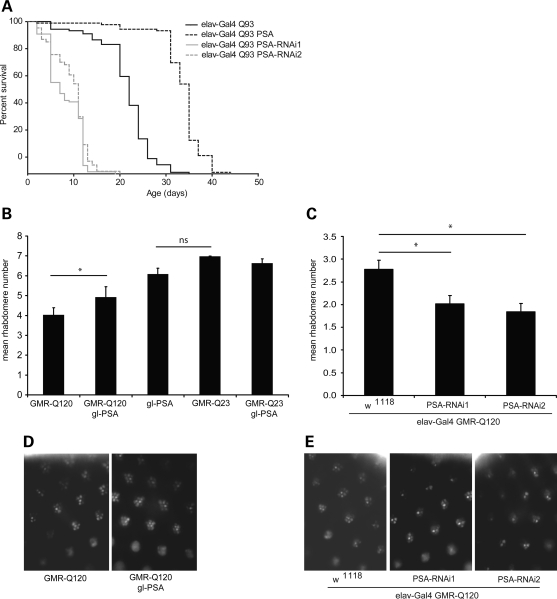Figure 4.
Effect of PSA overexpression and knockdown in Drosophila. (A) PSA expression levels alter lifespan in flies expressing htt-exon1 with 93 polyglutamine repeats in the brain. Knockdown of PSA expression levels by expression of two different PSA RNAi constructs enhanced toxicity (elav-Gal4 Q93 PSA-RNAi1 and elav-Gal4 Q93 PSA-RNAi2), compared with flies expressing mutant huntingtin alone (elav-Gal4 Q93). Overexpression of PSA (elav-Gal4 Q93 PSA) extended lifespan relative to flies expressing Q93 alone. Graph shows Kaplan–Meier survival curves, P < 0.0001 in both cases. Expression of PSA RNAi or PSA in flies expressing WT huntingtin (elav-Gal4 Q20) did not affect lifespan (Supplementary Material, Fig. S3). (B–E) Degeneration was also decreased by overexpression of PSA. Overexpression of PSA in the WT fly eye using the glass promoter (gl-PSA) caused a slight decrease in rhabdomere number compared with flies expressing Q23 alone. However, when co-expressed with GMR-Q120, PSA protected against the neurodegeneration seen in these flies (B). (C) Expression of PSA RNAi enhanced neurodegeneration in flies expressing GMR-Q120, using two RNAi lines (elav-Gal4 GMR-Q120 PSA-RNAi1 and elav-Gal4 GMR-Q120 PSA-RNAi2). Expression of PSA RNAi in flies expressing Q23 did not affect rhabdomere number (Supplementary Material, Fig. S3), *P < 0.02, 2 tailed t-test. (D) Examples of rhabdomeres in flies expressing GMR-Q120 with or without PSA (gl-PSA). (E) Examples of rhabdomeres in flies expressing mutant huntingtin GMR-Q120 when PSA is downregulated using two RNAi lines (PSA-RNAi1 and PSA-RNAi2).

